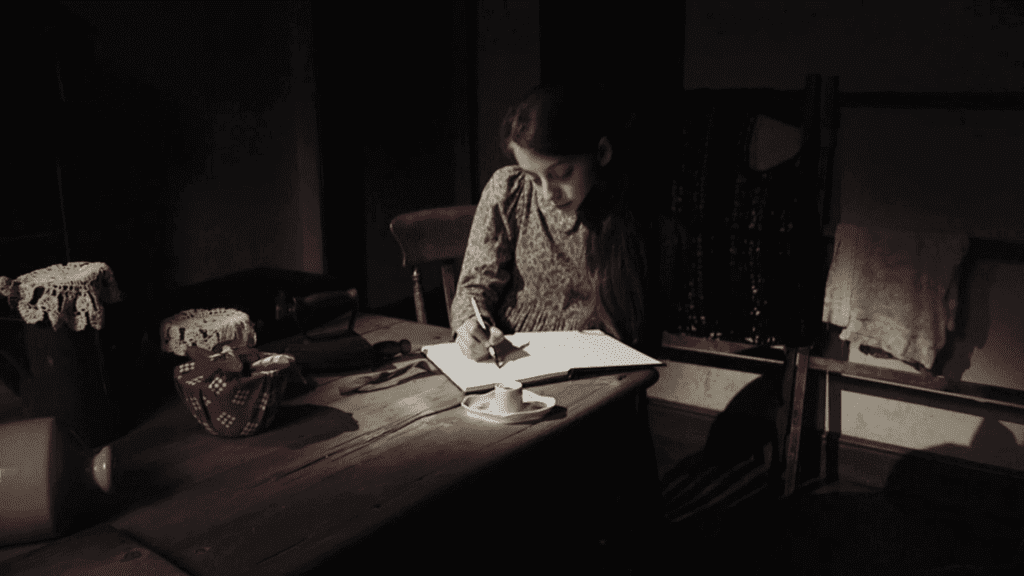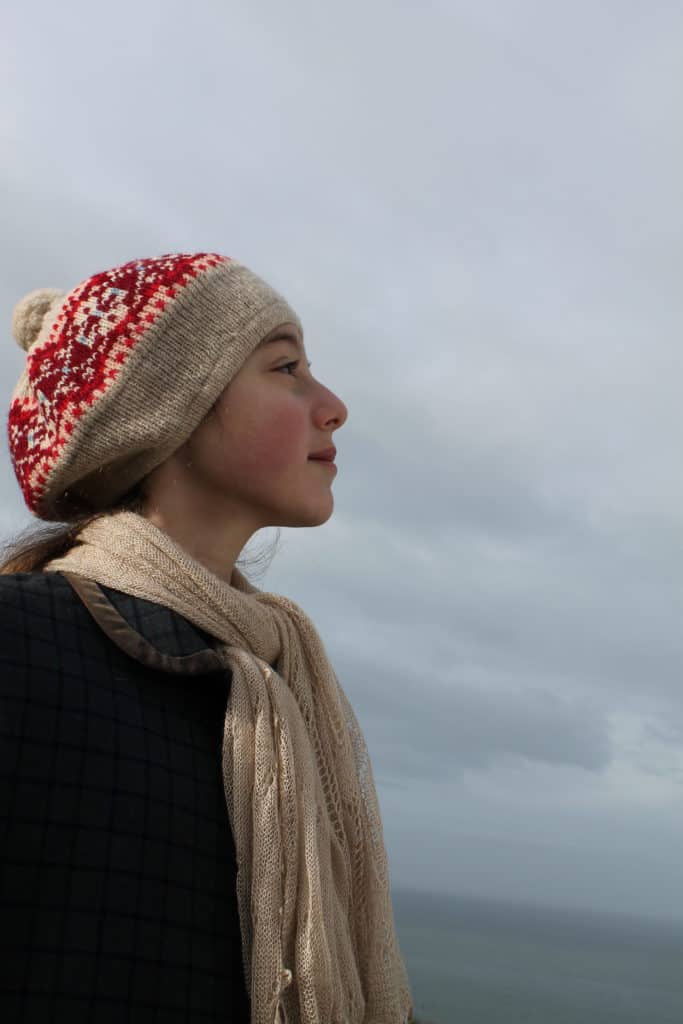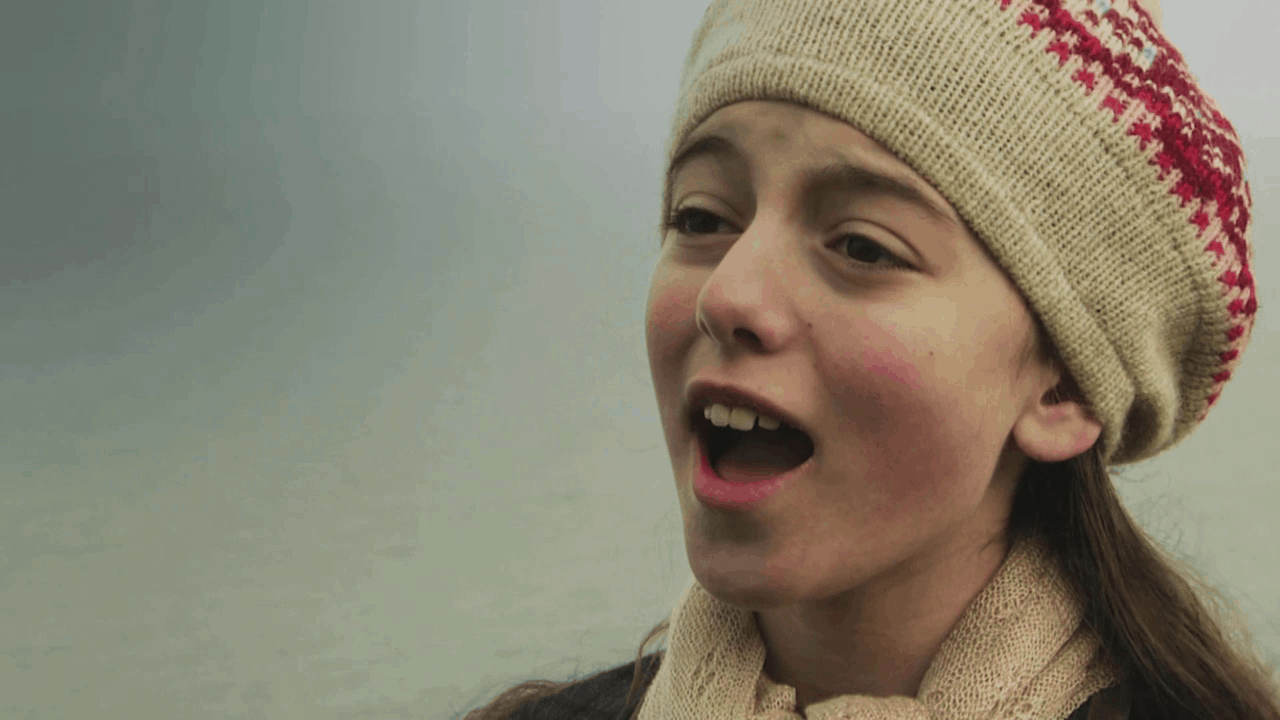
It’s Christmas Day and Betty, a schoolgirl played by Hollie Steel, is in the parlour of her family’s modest home – a home still in mourning following the loss of her father during the disaster of the Titanic.
Children on the Titanic is set in an industrial town near Netherton in the Midlands of England, where the anchor chain for the Titanic had been forged. In the Industrial Revolution this area became known as the Black Country – black by day with the soot and red at night from the burning furnaces.
Watch the Trailer
Children on the titanic
Britain’s Got Talent discovery Hollie Steel stars in the first TV programme ever made about the children and teenage crew members who sailed on the stricken liner.
Hollie plays a 14-year-old English girl emigrating to Canada with her parents.
Director Keith Wootton explains, “We look at what it was like for a child to be told the family was moving to the New World. The planning and goodbyes before the excitement of boarding the incredible Titanic. Children’s accounts of their feelings before and after the disaster are an important part of our story.”
The seven musical numbers in Children on the Titanic include two songs specially written for Hollie Steel, Women and Children First and The Melting Pot of Europe. In the final minutes of the film Hollie sings Nearer My God to Thee‘, believed to be the final hymn played by the Titanic Orchestra before the ship went down.
The story begins at Christmas 1912 with the girl played by Hollie Steel looking back at a year she’ll never forget. There are true to life accounts from children who survived and theories about teenage crew members from Titanic historians.
The story of RMS Titanic is a case study of mankind at its heroic best and at its selfish worst – one piece of the complex jigsaw that children of the 20th century consider when looking back at 100 years of fast-moving change.
Britain’s Got Talent discovery Hollie Steel stars in the first TV programme ever made about the children and teenage crew members who sailed on the stricken liner.
Hollie plays a 14-year-old English girl emigrating to Canada with her parents.
Director Keith Wootton explains, “We look at what it was like for a child to be told the family was moving to the New World. The planning and goodbyes before the excitement of boarding the incredible Titanic. Children’s accounts of their feelings before and after the disaster are an important part of our story.”
The seven musical numbers in Children on the Titanic include two songs specially written for Hollie Steel, Women and Children First and The Melting Pot of Europe. In the final minutes of the film Hollie sings Nearer My God to Thee‘, believed to be the final hymn played by the Titanic Orchestra before the ship went down.
The story begins at Christmas 1912 with the girl played by Hollie Steel looking back at a year she’ll never forget. There are true to life accounts from children who survived and theories about teenage crew members from Titanic historians.
The story of RMS Titanic is a case study of mankind at its heroic best and at its selfish worst – one piece of the complex jigsaw that children of the 20th century consider when looking back at 100 years of fast-moving change.
Cast & Locations

Hollie Steel
Thank you, Simon Cowell – ten years ago Hollie Steel gave millions of viewers one of the most memorable and emotional moments seen on Britain’s Got Talent. In 2009, when Hollie Steel was 10, she was singing on the live top-rated show when she momentarily forgot the words to ‘Edelweiss’. Hollie pleaded with judge Simon Cowell for a second chance and it was at this moment that her future singing career was in the balance.
Cowell was so impressed by Hollie’s singing voice and presentation that he famously gave Hollie a second chance which meant that the 10 o’clock news had to be delayed – a very rare occurrence. Three years later Hollie recorded the musical numbers for Children on the Titanic and was invited to play the central character, Betty, in the musical docudrama. At the time of writing, Hollie is now 21 and has just spent a year playing ‘Frenchy’ in the musical Grease on the world’s largest cruise ship Harmony of the Seas.
Interesting that Harmony of the Seas can carry 6.780 guests when all the berths are occupied compared with the world’s largest passenger ship of 1912, RMS Titanic, that had a capacity of 2.009. Along with modern technology, Hollie’s time on a modern-day cruise ship was, in part, made safer by innovations and regulations introduced after the sinking of the Titanic.
The star location for Children on the Titanic is the Black Country Living Museum in the heart of Britain’s Midlands – the birthplace of the Industrial Revolution.
The Black Country is a collection of 20 or so towns set around Dudley, Sandwell, Walsall and Wolverhampton. There are no exact boundaries to this region that built the world’s first successful steam engine, delivered the first steam train on US soil and forged the anchor for the Titanic. Black Country towns made some of the world’s earliest safes, vaults, cars, bicycles and motor-bikes. A tough place to live and work in bygone days.
The name of the Black Country was coined by an emissary of Abraham Lincoln who was scouting for arms to be shipped to the Union side in the American Civil War. In 1862 the American Consul Elihu Burritt famously described this hard-working characterful part of England as “black by day and red by night” having observed the ever-present black smog by day and the fiery glow of the furnaces at night.
Britain’s second largest city Birmingham, another giant of the Industrial Revolution, is just a few miles to the east of the Black Country. Birmingham is known to many TV viewers around the world as the home of the notorious Peaky Blinders street-gang of the 1900s – scenes for the drama series about this notorious gang were shot across the 28 acres of the Black Country Living Museum.
The buildings and backdrops of the open-air museum have been used for many films and documentaries set in the late 19th and early 20th centuries.
In 2017, the streets of the Black Country Museum were used in the biopic of comedy duo Laurel and Hardy. Stan & Ollie was a major release movie documenting what would become their farewell tour of the UK. The storyline shows them playing to dwindling audiences, dealing with past grievances, struggling with health problems and reminiscing about the past.
The museum was a perfect period setting for many scenes in Children on the Titanic. Children taking drama lessons from around the Black Country and Birmingham were auditioned and cast for the dramatic reconstructions along with local actors and street-players who regularly entertain visitors to the museum.
Other locations used for filming were the Merseyside seaside town of Southport and the Merseyside Maritime Museum in Liverpool. Titanic was registered in Liverpool and the museum houses a fine collection of exhibits of the doomed liner including many items from the wreck.

Hollie Steel as Betty
Thank you, Simon Cowell – ten years ago Hollie Steel gave millions of viewers one of the most memorable and emotional moments seen on Britain’s Got Talent. In 2009, when Hollie Steel was 10, she was singing on the live top-rated show when she momentarily forgot the words to ‘Edelweiss’. Hollie pleaded with judge Simon Cowell for a second chance and it was at this moment that her future singing career was in the balance.
Cowell was so impressed by Hollie’s singing voice and presentation that he famously gave Hollie a second chance which meant that the 10 o’clock news had to be delayed – a very rare occurrence. Three years later Hollie recorded the musical numbers for Children on the Titanic and was invited to play the central character, Betty, in the musical docudrama. At the time of writing, Hollie is now 21 and has just spent a year playing ‘Frenchy’ in the musical Grease on the world’s largest cruise ship Harmony of the Seas.
Interesting that Harmony of the Seas can carry 6.780 guests when all the berths are occupied compared with the world’s largest passenger ship of 1912, RMS Titanic, that had a capacity of 2.009. Along with modern technology, Hollie’s time on a modern-day cruise ship was, in part, made safer by innovations and regulations introduced after the sinking of the Titanic.
The star location for Children on the Titanic is the Black Country Living Museum in the heart of Britain’s Midlands – the birthplace of the Industrial Revolution.
The Black Country is a collection of 20 or so towns set around Dudley, Sandwell, Walsall and Wolverhampton. There are no exact boundaries to this region that built the world’s first successful steam engine, delivered the first steam train on US soil and forged the anchor for the Titanic. Black Country towns made some of the world’s earliest safes, vaults, cars, bicycles and motor-bikes. A tough place to live and work in bygone days.
The name of the Black Country was coined by an emissary of Abraham Lincoln who was scouting for arms to be shipped to the Union side in the American Civil War. In 1862 the American Consul Elihu Burritt famously described this hard-working characterful part of England as “black by day and red by night” having observed the ever-present black smog by day and the fiery glow of the furnaces at night.
Britain’s second largest city Birmingham, another giant of the Industrial Revolution, is just a few miles to the east of the Black Country. Birmingham is known to many TV viewers around the world as the home of the notorious Peaky Blinders street-gang of the 1900s – scenes for the drama series about this notorious gang were shot across the 28 acres of the Black Country Living Museum.
The buildings and backdrops of the open-air museum have been used for many films and documentaries set in the late 19th and early 20th centuries.
In 2017, the streets of the Black Country Museum were used in the biopic of comedy duo Laurel and Hardy. Stan & Ollie was a major release movie documenting what would become their farewell tour of the UK. The storyline shows them playing to dwindling audiences, dealing with past grievances, struggling with health problems and reminiscing about the past.
The museum was a perfect period setting for many scenes in Children on the Titanic. Children taking drama lessons from around the Black Country and Birmingham were auditioned and cast for the dramatic reconstructions along with local actors and street-players who regularly entertain visitors to the museum.
Other locations used for filming were the Merseyside seaside town of Southport and the Merseyside Maritime Museum in Liverpool. Titanic was registered in Liverpool and the museum houses a fine collection of exhibits of the doomed liner including many items from the wreck.
